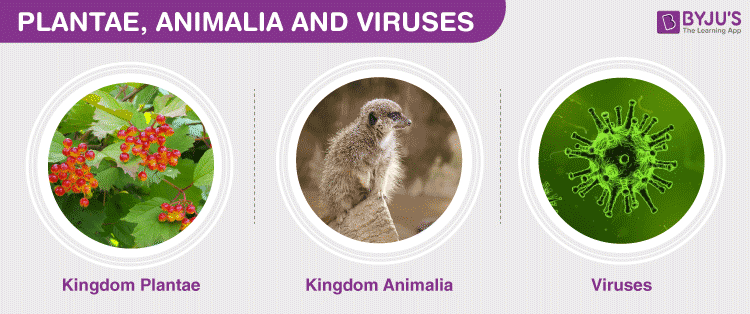
Kingdom Plantae
It consists of all the plants that we see around us. They belong to that level in the organization in which the organisms are classified to be multicellular, with the cell wall and follow the autotrophic mode of nutrition.
However, we do have a few exceptions like the pitcher plant, which is a heterotroph as it feeds on insects. There also exist a few parasitic plants like Cuscuta. The members of kingdom Plantae have a unique life cycle which follows alternation of generation between two phases – diploid sporophytic phase and haploid gametophytic phase.
Further Reading: Plant Kingdom
Kingdom Animalia

Kingdom Animalia occupies the level belonging to the eukaryotic, multicellular and heterotrophic organisms in the hierarchy of classification. The organisms in this kingdom lack cell walls.
They show all levels of organization in structure, i.e. they range from primitive organization to a proper organ system level of organization. Most of the members of kingdom Animalia are capable of locomotion. They show growth and differentiation during their lifetime, and most of them are capable of the sexual mode of reproduction.
Read More: Animal Kingdom
Viruses
Even after the establishment of the five-kingdom classification, some organisms could not be placed in any of the five kingdoms. These included viruses, viroids, and prions. Viruses could not be placed in any of the kingdoms because they are practically neither live nor dead.
Viruses consist of genetic material, i.e. nucleic acid (DNA or RNA) surrounded by a protein capsule. Viruses take shelter on other living organisms and use the host machinery to replicate and produce multiple copies of them. Thus, resulting in more number of viruses to spread the infection.
The virus is usually smaller than bacteria in size. The first virus to be discovered was the Tobacco mosaic virus (TMV). They infect the tobacco plant.
Viroids are smaller than viruses, and unlike viruses, they lack any protein coating. Thus, they are free-living RNA.
Prions are infectious proteins. They are known to cause neurodegenerative diseases. Prions are misfolded proteins and can transfer the same to the normal variant of the same protein. Creutzfeldt-Jakob disease (CJD) is one example of the disease caused by prions in humans.
Read More: Virus
Frequently Asked Questions
1. What are the significant features of kingdom Plantae
Most members of kingdom Plantae are autotrophs, which means they can use photosynthesis to prepare their own food. However, there are certain exceptions to this – some plants may consume insects and small animals to gain additional nutrients.
2. What are the significant features of kingdom Animalia?
All members of this kingdom are heterotrophs, which means they rely on other organisms to acquire food.
Register at BYJU’S Biology to learn more about Kingdom Animalia, Plantae, and Viruses.

Comments